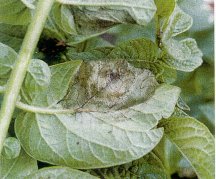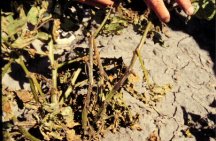Integrated Management of Late Blight in Potatoes
Introduction
Late blight has been a problem for potato growers in North America since the 1840s. In recent years, significant changes in isolates of late blight fungus have been recorded, including changes in agressiveness to potato and tomato plants, optimal temperature range and also sensitivity to metalaxyl fungicide. In the past few years has resulted in new, more aggressive strains of the fungus, some of which are fungicide-resistant.
Since, late blight is a community disease, for effective control integrated management MUST be adopted by all producers, large and small, including organic farmers, home gardeners and other specialized growers; by pesticide and equipment manufacturers and suppliers; and by government agencies, extension specialists and crop consultants.
Fungicides cannot be used alone for effective control of late blight, but must be used as one tool in an integrated management strategy. Cultural practices are the first line of defense, and forecasting techniques and proper application technology are essential for efficient, targeted applications of fungicides.
All fungicides, old or new, must be used as protectants before late blight is established in the crop. Attempting to use any fungicide to eradicate the disease after it is well established promotes the selection and spread of new fungicide resistance.

Figure 1. Field infestation of late blight
Symptoms
The first symptoms of late blight are small, light green, water-soaked spots that usually develop on the lower leaves. Under favorable, cool, moist weather conditions, the spots rapidly enlarge into dark brown spreading spots. These spots are not limited by leaf veins as with early blight.
Under the cool, moist conditions of early morning, a grayish-white mildew comprised of fungal mycelium and spores develops on the under-surface of the lesions. The outer margin of the lesion is surrounded by a pale green to yellow border. Lesions on the stems appear water-soaked and are dark green to black in color. Plants that are severely affected by late blight have a distinctive odor as a result of the rotting leaf and stem tissue.
Tubers become infected when spores from the leaves and/or stems come in contact with tubers. Spores may be washed into the soil, or contact tubers at harvest. Tuber symptoms are characterized by an irregular reddish brown staining of the tissue immediately below the potato skin. A dry rot may result in slightly depressed areas in association with the reddish brown color. Late blight infected tubers are susceptible to other bacterial and fungal rots, and because of this infected tubers are difficult to store.

Figure 2. Late blight on potato leaf
Prevention and Control
The most important aspect of late blight management is to eliminate or reduce the initial source of the disease each season. Sources of disease include infected seed, cull piles and volunteers. The late blight fungus survives well under the same conditions that permit the survival of tubers. Spores become airborne from these initial sources and spread to susceptible and unprotected crops.
Healthy Seed
Obtain seed from farms with effective disease management practices. The use of certified seed is highly recommended. Grade seed carefully while cutting, and discard suspicious-looking tubers and seed pieces.
Sanitation and Cull Clean-up
Follow a program of sanitation for storage facilities and equipment to eliminate sources of the disease. Avoid leaving tubers, including debris or slivers from seed cutting, in cull piles for any length of time. Avoid uncovered cull piles during the growing season. Check with local authorities for methods of disposal.
Forecasting Techniques and Scouting Systems
To effectively schedule preventative fungicide applications and eliminate unnecessary fungicide use, local weather forecasts and disease forecasting programs should be used to identify periods conducive to disease development. Scout fields regularly to detect early if there is any disease in the field and other sources of disease. Wind-protected areas of the field, near tree-line or in low areas of the field often stay moist longer and should be monitored.

Figure 3. Late blight stem lesion
Cultural Practices
Use proper cultural practices, including the following, as the first line of defense:
- Avoid planting in fields or areas of fields that cannot be easily sprayed with fungicide
- Increase spacing of plants to reduce canopy density
- Promptly remove or destroy volunteer potatoes found in other crops grown in rotations or elsewhere
- Control weed hosts, such as hairy nightshade
- Use proper hilling to reduce infection in tubers
- Carefully manage irrigation to avoid increasing disease risk through prolonged periods of wetness
- Identify and destroy hot spots of infection in a field to reduce production and spread of spores. Bag and destroy individual plants, or use chemical and fungicide treatments for larger areas.
Harvesting, Grading and Storage Monitoring
Harvest only when vines, both leaves and stems, are completely desiccated. Harvest suspect, shaded or wet areas after rest of the harvest is complete.
Grade potatoes and remove infected tubers prior to storage.
Monitor storage facilities for "hot spots" which indicate the start of storage breakdown due to rots. Carefully manage airflow, humidity and temperature to reduce storage losses.
Scheduled Fungicide Programs
Use fungicides as part of a preventative program. No fungicide is effective in eradicating disease that has already set in. Attempting to use fungicides as curatives can promote the spread of fungicide resistance in the pathogen. Consult the current edition of the Manitoba Guide to Field Crop Protection for recommended fungicides.
Begin a fungicide program early in the season, always before disease develops, and continue through until harvest. Scouting programs, disease forecasts based on local weather conditions, and stage of crop development should be used to determine when to begin applications and to adjust the timing of applications during the growing season. Crops should be monitored throughout the growing season (spring culls to harvested crops) for late blight.
Always follow fungicide label instructions for application rates, spray intervals and limitations on numbers of sprays. Do not exceed the label’s application rates. Spray intervals are generally seven to 10 days for contact fungicides and 10 to 14 days for systemic fungicides. When disease potential is high, such as during rapid plant growth or heavy rains, the shorter spray intervals on the label should be used. When disease potential is lower, such as during extended hot dry weather, the longer spray intervals listed on the label are appropriate.
When the maximum number of applications of a fungicide is reached, switch to an unrelated alternate product with a different mode of action.
Pathogen populations should be monitored for sensitivity to metalaxyl or other fungicides for which resistance may be a problem. When resistance to a fungicide is identified in a field, use of that fungicide should be discontinued. Rotate between different fungicide groups or use tank mixtures of different fungicides, particularly when using fungicides that enter plant tissues or have single or limited-site activity against the fungus.
Organic farmers may be able to use certain copper-based fungicides as part of an integrated disease management plan and maintain organic certification. It is critical to consult the product label to confirm if it is acceptable for use in organic production.

Figure 4. Tuber infected with late blight
Fungicide Application
When applying fungicides, complete coverage of the foliage (stems and leaves, top to bottom of canopy) with fungicide is necessary to enable disease prevention, regardless of the application methods (ground or air, traditional or newer technology sprayers). To ensure adequate coverage of plants, use equipment designed for and appropriate to fungicide applications. Do not over-extend your acreage beyond what your sprayer equipment can cover in the minimum time available, including bad weather. For example, do no more than two to three days’ acreage capacity per machine. Use adequate water volumes and increase water volume as the crop grows. Ensure regular and proper equipment calibration.
